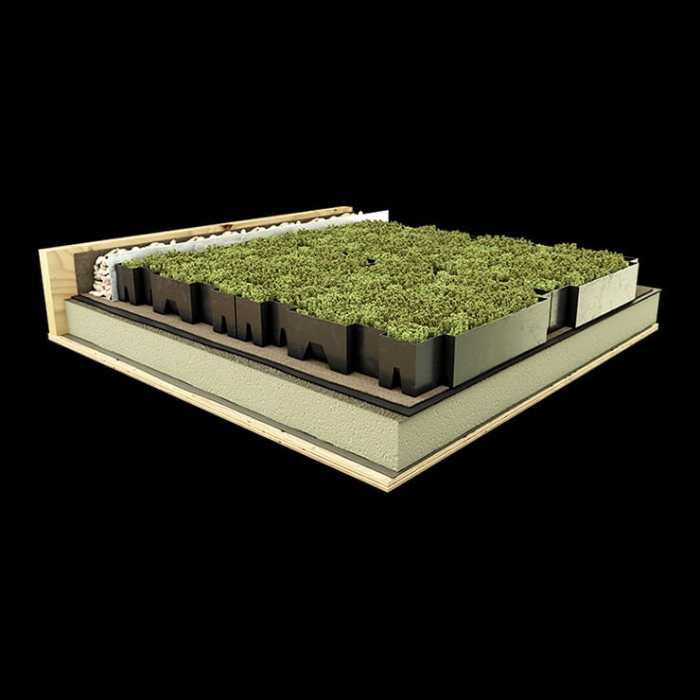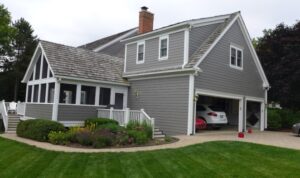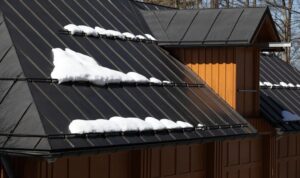Green roofing systems for urban homes provide a sustainable solution to modern city living, offering a range of benefits that go beyond traditional roofing options. From energy efficiency to environmental advantages, these systems play a crucial role in creating a greener and more eco-friendly urban landscape.
Let's delve into the world of green roofing systems and explore how they are revolutionizing the way we think about urban architecture.
As we navigate through the different types, installation process, and design aspects of green roofs, we uncover a wealth of information that showcases the innovation and creativity behind this growing trend in urban development.
Benefits of Green Roofing Systems

Green roofing systems offer numerous benefits to urban homes, making them a sustainable and eco-friendly choice for homeowners.
Energy Efficiency
Green roofs provide excellent insulation, reducing the need for heating and cooling in urban homes. By regulating indoor temperatures, they help lower energy consumption and utility bills.
Environmental Advantages
Installing green roofs in urban areas helps improve air quality by absorbing carbon dioxide and filtering pollutants. They also promote biodiversity by creating habitats for birds, insects, and plants in densely populated cities.
Impact on Urban Heat Island Effect
Green roofing systems play a crucial role in reducing the urban heat island effect by absorbing heat and reducing surface temperatures. This helps mitigate the heat trapped in urban areas, creating a more comfortable and sustainable living environment.
Cost-Effectiveness
While the initial cost of installing a green roof may be higher than traditional roofing options, the long-term savings on energy bills and maintenance costs make it a cost-effective investment. Green roofs also have a longer lifespan than conventional roofs, providing additional savings over time.
Types of Green Roofing Systems

Green roofing systems come in different types, each with its own unique features and maintenance requirements. Let's explore the three main types commonly used for urban homes: extensive, intensive, and semi-intensive green roofs.
Extensive Green Roofs
Extensive green roofs are lightweight and low maintenance, making them ideal for urban homes. These roofs typically consist of a thin layer of soil and drought-resistant plants like sedum. The shallow root system of these plants requires minimal maintenance, such as occasional watering and weeding.
Extensive green roofs are cost-effective and provide insulation for the home.
Intensive Green Roofs
Intensive green roofs are more elaborate and require a thicker layer of soil to support a wider variety of plants, including trees and shrubs. These roofs are like rooftop gardens and can create a lush outdoor space for urban homeowners.
Intensive green roofs need regular maintenance, such as watering, fertilizing, and pruning. While they require more effort to upkeep, intensive green roofs offer a greater aesthetic appeal and can even provide food-growing opportunities.
Semi-Intensive Green Roofs
Semi-intensive green roofs fall between extensive and intensive green roofs in terms of maintenance and plant variety. They have a moderate amount of soil depth, allowing for a mix of plants like grasses, perennials, and small bushes. Semi-intensive green roofs require regular watering and occasional maintenance like pruning and fertilizing.
These roofs strike a balance between visual appeal and maintenance needs, making them a popular choice for urban homes.Examples of successful urban homes with different types of green roofs can be found in cities like New York, Chicago, and Portland.
These homes showcase the versatility and benefits of green roofing systems in urban environments, providing inspiration for homeowners looking to incorporate eco-friendly solutions into their living spaces.
Installation Process of Green Roofs
When it comes to installing a green roofing system on an urban home, there are several important steps to consider. From structural considerations to waterproofing and drainage systems, each aspect plays a crucial role in the success of your green roof project.
Structural Considerations
Before installing a green roof, it is essential to assess the structural integrity of your building. Ensure that the roof can support the additional weight of the green roof, including the soil, plants, and drainage system. Consulting with a structural engineer is recommended to determine if any reinforcements are needed.
Waterproofing and Drainage Systems
Proper waterproofing is key to the longevity of your green roof. A high-quality waterproof membrane should be installed to prevent leaks and water damage. Additionally, a well-designed drainage system is essential to ensure excess water is efficiently removed from the roof.
Consider incorporating a drainage layer, filter fabric, drainage mat, and drainage outlets to maintain proper water flow.
Selecting the Right Plants
Choosing the right plants for your green roof is crucial, especially in an urban setting. Opt for native plants that can thrive in your local climate and require minimal maintenance. Sedums, grasses, and wildflowers are popular choices for green roofs due to their ability to withstand harsh conditions and provide habitat for pollinators.
Consider factors such as sunlight exposure, wind exposure, and soil depth when selecting plants for your green roof.
Green Roofing System Design and Aesthetics
Green roofing systems not only provide environmental benefits but also contribute to the aesthetic appeal of urban homes. The design of green roofs plays a crucial role in enhancing the overall look of a building and integrating nature into the urban landscape.
Integration of Green Roofs in Urban Home Design
When incorporating green roofs into urban homes, it is essential to consider the overall design and architecture of the building. The green roof should seamlessly blend with the existing structure while adding a touch of greenery to the urban environment.
Innovative design elements such as roof gardens, planters, and pathways can be incorporated to create a visually appealing and functional green roof.
Examples of Innovative Design Elements
- Roof Gardens: Creating a garden on the rooftop not only adds greenery but also provides a space for relaxation and social gatherings.
- Planters and Vegetation: Strategic placement of planters and vegetation can enhance the aesthetics of the green roof and promote biodiversity.
- Pathways and Seating Areas: Including pathways and seating areas on the green roof allows residents to enjoy the outdoor space and connect with nature.
Tips for Creating a Visually Appealing Green Roof
- Choose a variety of plants to create a diverse and colorful green roof.
- Consider the weight-bearing capacity of the roof when designing the green roof to ensure safety.
- Incorporate sustainable irrigation systems to maintain the green roof efficiently.
- Consult with a professional designer or architect to ensure the green roof complements the overall design of the urban home.
Epilogue
In conclusion, green roofing systems for urban homes offer a sustainable and aesthetically pleasing solution to the challenges of modern city living. By incorporating these eco-friendly systems into urban architecture, we not only enhance energy efficiency and environmental benefits but also elevate the overall quality of life in our cities.
Embrace the green roof revolution and transform the concrete jungle into a thriving oasis of sustainability.
Q&A
How do green roofing systems benefit urban homes in terms of energy efficiency?
Green roofing systems provide natural insulation, reducing the need for artificial heating and cooling, which leads to lower energy consumption.
What are the maintenance requirements for different types of green roofing systems?
Extensive green roofs require minimal maintenance, while intensive green roofs need more care due to the variety of plants and features. Semi-intensive roofs fall in between the two in terms of maintenance needs.
How can green roofs be integrated into the overall design of urban homes?
Green roofs can be incorporated into the architectural design by blending them seamlessly with the structure, creating a harmonious and visually appealing rooftop garden.






